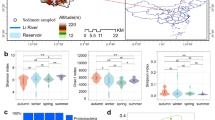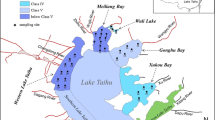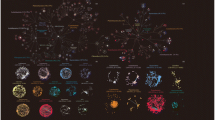Abstract
The total viable count, population density of Escherichia coli and coliform bacteria, and nitrogen in the microbiomass (microbiomass-N) in sediments were monitored monthly at 12 points in the Ongagawa River basin from June 2002 to May 2006. The measurement of the sediment microbiomass-N was used for evaluation of the sediment’s microbial population in the river ecosystem. An extraordinarily high population of E. coli was observed during the season when there was stagnant water in the basin, with a high population and an insufficient drain diffusion system, and, thus hydrological water control is indispensable to prevent rapid E. coli growth. Microbiomass-N in sediments showed a negative correlation or independent fluctuation in relation to the bacterial population in the water column of the river. Seasonal changes in extracted nitrogen (N) in river sediments did not show correspondence with microbiomass-N in sediments. The microbiomass-N in sediments changed independently of the bacterial population in the river water, indicating that the high population of bacteria in the water does not lead to a high microbial population in river sediments. Ordination of the microbial parameters by canonical correspondence analysis (CCA) showed that microbiomass-N in sediments was quite different from other parameters. Relatively higher H+ (lower pH), PO4 3− concentration and dissolved oxygen (DO) were the determinant parameters of higher microbiomass-N in sediments. A relative microbial abundance between the water column and sediments as well as each of the microbial populations in the water column and sediments could be a quantitative parameter for evaluating the biochemical processes of stream water.





Similar content being viewed by others

References
Bott TL, Brock JT, Dunn CS, Naiman RJ, Ovink RW, Petersen RC (1985) Benthic community metabolism in four temperate stream systems: an inter-biome comparison and evaluation of the river continuum concept. Hydrobiologia 123:3–45
Brake M, Höper H, Joergensen RG (1999) Land use-induced changes in activity and biomass of microorganisms in raised bog peats at different depths. Soil Biol Biochem 31:1489–1497
Brown SS, King DK (1987) Community metabolism in natural and agriculturally disturbed riffle sections of the Chippewa River, Isabella County, Michigan. J Freshw Ecol 4:39–51
Busch DE, Fisher SG (1981) Metabolism of a desert stream. Freshw Biol 11:301–307
Champiat D, Larpent JP (1978) Aquatic microflora enumeration by means of adenylic nucleotides dosage. Hydrobiologia 58:37–42
Elwood JW, Newbold JD, Trimble AF, Stark RW (1981) The limiting role of phosphorus in a woodland stream ecosystem: effects of P enrichment on leaf decomposition and primary producers. Ecology 62:146–158
Fuss CL, Smock LA (1996) Spatial and temporal variation of microbial respiration rates in a blackwater stream. Freshw Biol 36:339–349
Gelroth JV, Marzolf GR (1978) Primary production and leaf-litter decomposition in natural and channelized portions of a Kansas stream. Am Midl Nat 99:238–243
Grimm NB, Fisher SG (1984) Exchange between interstitial and surface water: implications for stream metabolism and nutrient cycling. Hydrobiologia 111:219–228
Hedin LO (1990) Factors controlling sediment community respiration in woodland stream ecosystems. Oikos 57:94–105
Hill BH, Gardner TJ (1987) Benthic metabolism in a perennial and an intermittent Texas prairie stream. Southwest Nat 32:305–311
Hill BH, Herlihy AT, Kaufmann PR, Sinsabaugh RL (1998) Sediment microbial respiration in a synoptic survey of mid-Atlantic region streams. Freshw Biol 39:493–501
Hill BH, Hall RK, Husby P, Herlihy AT, Dunne M (2000) Interregional comparisons of sediment microbial respiration in streams. Freshw Biol 44:213–222
Michiki K, Haraguchi A, Kadono T, Kawano T, Nakazawa K, Nishihama S, Suzuki T, Uezu K, Yahata Y, Yoshizuka K (2005) Spatial and seasonal variations of water chemical environments of the Ongagawa River. Environ Sci 18:339–348
Peters GT, Webster JR, Benfield EF (1987) Microbial activity associated with seston in headwater streams: effects of nitrogen, phosphorus and temperature. Freshw Biol 18:405–413
Sinsabaugh RL (1997) Large-scale trends for stream benthic respiration. J North Am Benthol Soc 16:119–122
Smith LK, Sartoris JJ, Thullen JS, Andersen DC (2000) Investigation of denitrification rates in an ammonia-dominated constructed wastewater-treatment wetland. Wetlands 20:684–696
Stumm W, Morgan JJ (1995) Regulation of the chemical composition of natural waters. In: Aquatic chemistry, chemical equilibria and rates in natural waters, 3rd edn. Wiley, New York, pp 872–934
Thamdrup B, Fleischer S (1998) Temperature dependence of oxygen respiration, nitrogen mineralization, and nitrification in Arctic sediments. Aquat Microb Ecol 15:191–199
Vance ED, Brookes PC, Jenkinson DS (1987) An extraction method for measuring soil microbial biomass C. Soil Biol Biochem 19:703–707
Wieder RK, Lang GE (1984) Influence of wetlands and coal mining on stream water chemistry. Water, Air, Soil Pollut 23:381–396
Wright JC, Mills IK (1967) Productivity studies on the Madison River, Yellowstone national park. Limnol Oceanogr 12:568–577
Acknowledgments
The authors are grateful to Ms. K. Shikasho, Ms. E. Jikuya, Ms. Y. Yahata, Dr. T. Kadono, Mr. D. Sugiura, Mr. D. Miyamoto, Mr. Y. Suzuka, and Mr. Y. Tanaka for their assistance with experiments. The analysis of the samples was carried out at the Instrumentation Center of The University of Kitakyushu. This work was financially supported by a special research grant from the University of Kitakyushu.
Author information
Authors and Affiliations
Corresponding author
Rights and permissions
About this article
Cite this article
Nishihama, S., Haraguchi, A., Kawano, T. et al. Seasonal changes in the microbial population of the water column and sediments of the Ongagawa River, northern Kyushu, Japan. Limnology 9, 35–45 (2008). https://doi.org/10.1007/s10201-008-0236-6
Received:
Accepted:
Published:
Issue Date:
DOI: https://doi.org/10.1007/s10201-008-0236-6



